Term 2 Chapter 1 | 5th Science - Food | 5th Science : Term 2 Unit 1 : Food
Chapter: 5th Science : Term 2 Unit 1 : Food
Food
UNIT 1
FOOD

Learning Objectives
After completing this lesson, students
will be able to:
* know about spoilage of food and the
food preservation methods.
* list out the deficiency diseases and
the prevention methods.
* know about obesity and the method of
calculation of BMI.
* understand the importance of balanced
diet.
* identify the safety measures to be
followed in the kitchen.
Introduction
Our body needs nutrients like proteins,
carbohydrates and fats for its proper functioning. We get these nutrients from
the food we eat. If we do not take all these nutrients in right proportion, it
results in some diseases. Sometimes, we do not preserve the food properly and
it gets spoiled. Sometimes through the spoiled food also we get diseases. So,
we need to preserve the food we eat. In this lesson we will study about
spoilage of foods and the ways to preserve them, deficiency diseases, balanced
diet and also about kitchen safety.
I. Spoilage of Food
Food items like fruits, vegetables, milk
and meat will be fresh for very short time. These are called perishable foods
and they get spoiled easily. Some food items like rice have long life time but
they also decompose. The change in the normal state of the food is called
spoilage of food. Spoiled food becomes unsuitable to eat. We can notice such
changes from the taste and smell of the spoiled food. Eating spoiled food
results in diseases.
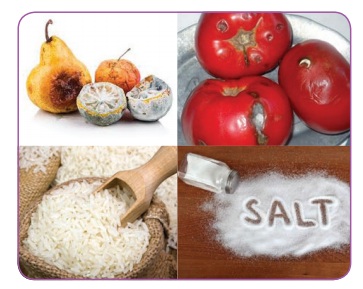
Activity 1
Classify the following
into perishable and non-perishable food items.
Salt, Sugar, Apple, Corn,
Orange, Wheat, Pulses, Tomato, Papaya, Rice, Cucumber.
Perishable: Apple, Orange, Salt, Tomato, Papaya, Cucumber Non-perishable: Sugar, Corn, Wheat, Pulses, Rice
1. Causes
Once the food items are harvested they begin to decompose. Food can be spoiled by factors like air and oxygen, moisture, enzymes, microorganisms, light and temperature.
Air
and Oxygen: When oxygen reacts with food contents,
it produces changes in the colour and flavour of the food.
Moisture:
Moisture keeps the food fresh. When the moisture is gone vegetables and fruits
shrink. Due to evaporation, moisture loss occurs in foods like meat, fish and
cheese.
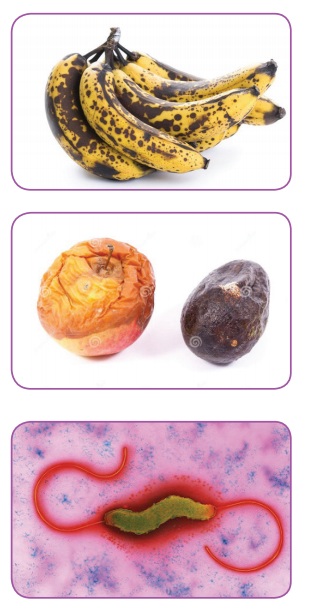
Enzymes:
Enzymes break down the tissues and components of the food in different ways
like oxidation, browning and ripening. So the food items decay.
Microorganisms:
Microorganisms such as fungi, yeast and bacteria can grow well in low
temperatures. They multiply in food and spoil them.
Light:
Light produces colour changes and also vitamin loss.
Temperature: Sometimes rise in temperature causes food spoilage.
Activity 2
Look at the fruits and
vegetables in your house. Is there any spoiled one? Find out the reason for
that.
2. Effects
Spoiled
foods are not suitable to eat. They may not be fresh and tasty. Sometimes it
will be harmful to consume them. Microorganisms present in spoiled foods may
cause foodborne diseases like stomach pain, fever, dysentery, vomiting and
indigestion.
II. Preservation of Food
The process of keeping the food
materials for a long time without getting spoiled is called preservation of
food. Food will be spoiled if it is not prepared, preserved and handled in the
right way. There are many methods used to prevent, delay and reduce the
spoilage of food.
1. Food Preservation Methods
Cultivation
of food requires lot of efforts. Nowadays food cultivation and the crop yield
are decreasing. There are many people suffering in the world without food. So,
we need to protect and preserve the food. The following are the ways to
preserve food.
Drying: It is the removal of water content
from the food by drying it in the sunlight. E.g. Grains
Addition
of salt: When salt
is added to food, it removes the water from the food. E.g. Fish, Pickles
Addition
of sugar: When sugar
is added to food, it dissolves in the water content of the food and preserves
the food items from spoilage. E.g. Jam, Fruit juices.

Do you know?
While purchasing packed
food items, we should check the following details.
1. Manufactured date
2. Expiry date
3. Ingredients
4. Energy content of the
food material.
Freezing: The microbial growth and the enzyme
activity on the frozen food items can be prevented by this method. E.g. Fruits,
Vegetables.
Boiling: It kills the microorganisms present
in the food materials. E.g. Milk, Water.
Canning
and bottling:
In this method, food is packed in air tight cans so that germs do not grow on
them.E.g. Milk powder.
Addition
of chemical preservatives: Chemical
preservatives are added to stop the growth of micro-organisms in certain food
materials. E.g. Sodium benzoate is added with fruits, Sulphur dioxide is added
with dry fruits, Vinegar is added with pickles.

Do you know?
Irradiation is a modern
method by which, food is exposed to gamma rays or ultra violet rays to kill the
bacteria and the mould. It does not affect the taste of the food or nutritive
value of the foods. E.g. Onion, Potatoes.
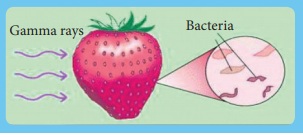
2. Purpose of Food Preservation
Modern technologies have increased the
food production. But, practicing agriculture is abandoned in many places as
there is failure of monsoon. At that same time many people suffer in the world
without food. So, food should not be wasted by any means. Preservation of food
is important for the following reasons.
1. To retain the colour, taste and
nutritive value of the food.
2. To make food available throughout the
year.
3. To prevent the growth of
microorganisms like bacteria and fungi in the food items.
4. To reduce the wastage of food
materials.
5. Preserving food not only protects our
health but also makes food available to the people who need it.
III. Obesity
Obesity and overweight are defined as
abnormal or excessive fat accumulation in the body that may affect the health.
Obesity is most commonly caused by excessive food intake, lack of physical
activity and also genetic reasons. Obese people take more food but work very
less. When they eat more and work less, excess energy is accumulated as fat and
creates problems. Obesity increases the likelihood of heart disease, diabetes
and high blood pressure.
1. Prevention
Obesity is mostly related to our life style and habits. Eating healthy foods and having regular physical activity can reduce obesity and overweight. It is important that you maintain proper weight in the young age.
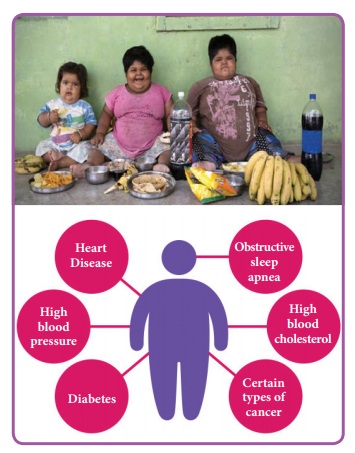
In order to avoid obesity and overweight you need to do the following.
1. Avoid fast foods, fried items and
meat with more fat.
2. Eat fruits and vegetables, legumes,
whole grains and nuts.
3. Do regular physical exercises.
4. Don’t play games in computer and
mobile phones.
5. Have proper sleep time.

2. Body Mass Index
People are generally classified as obese
and overweight based on Body Mass Index (BMI). Body mass index is obtained by
dividing as a person’s weight in kilograms by the square of his height in
metres (kg/m2).
Do you know?
People with BMIs between
18.5 and 25 have less chance of developing diseases like cancer, heart disease
and diabetes.
If the BMI is over 30 kg/m2 people
are said to be obese and the range of 25– 30 kg/m2 denotes
overweight.
BMI of a person with 60 kg weight and a
height of 190 cm can be calculated as below.
BMI = Weight in kg / Height in m2
= 60 / [ 1.90 × 1.90 ]
= 60 / 3.61 = 16.62
Activity 3
Find your B.M.I
My B.M.I = [ My weight
---- kg ] / [ My height ---- in m2 ]
IV. DISEASE
A disease is an abnormal condition that
affects a living organism. This abnormal condition affects the structure and
function of the organism. Diseases may be caused by external factors as well as
internal dysfunction. Each disease has symptoms. We come to know about the
diseases from their symptoms.
1. Causes of Diseases
Diseases are caused by microorganisms
like bacteria, virus, protozoa and fungi. They are transmitted by insects, and
also through contaminated air and water. Some diseases are caused when the
function of the organ is affected. In general, causes of diseases can be
classified as below.
* Metabolic factor. E.g. Diabetes
* Genetic factor. E.g. Colour blindness
* Microorganisms. E.g. Bacterial
diseases
* Nutritional factor. E.g. Marasmus
* Environmental factor. E.g. Cholera

Activity 3
Find out the common disease
prevalent in your area. Find out the reason for them and discuss with your
teacher how to get remedy for them.
2. Types of Diseases
There are four main types of diseases.
They are:
* Infectious diseases
* Hereditary diseases
* Physiological diseases
* Deficiency diseases
Do you know?
More number of people die
every year due to heart disease than any other diseases.
a. Infectious diseases
Infectious
diseases are caused by microorganisms which invade our body and multiply inside
them. These diseases are spread from one person to another. E.g.Common cold.
b. Hereditary diseases
Hereditary
diseases occur due to abnormalities in the gene. These diseases are passed from
parents to children. E.g.Heart disease.
c. Physiological diseases
Diseases
which are caused due to malfunction of the body organs are called physiological
diseases. E.g.Asthma.
d. Deficiency diseases
![]() A diet which contains all essential nutrients in correct
proportion is indispensable for maintaining good health. Deficiency in one or
more of the nutrients causes various diseases. These are called deficiency
diseases.
A diet which contains all essential nutrients in correct
proportion is indispensable for maintaining good health. Deficiency in one or
more of the nutrients causes various diseases. These are called deficiency
diseases.
* Protein deficiency diseases
Marasmus
and Kwashiorkor are the protein deficiency diseases. In marasmus, the child
loses weight and it will appear as though bones are covered by skin. In
Kwashiorkor, the child develops an enlarged belly with swollen face and feet.
By eating protein rich foods like egg, milk, fish and green leafy vegetables we
can avoid protein deficiency diseases.
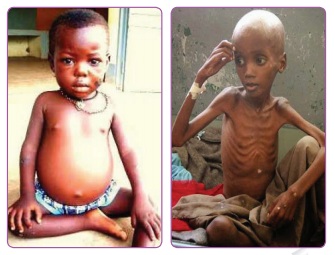
Do you know?
Kwashiorkor disease is found more among people in developing countries. It is because their diet is high in carbohydrates which is cheaper and low in proteins. As they live below poverty line, they couldn’t afford protein rich food which is costly.
* Vitamin and mineral deficiency diseases
Certain
diseases are caused by deficiency of vitamins and minerals. By eating vitamin
and mineral rich food items, we can avoid these diseases. The following table
gives some of the diseases caused by deficiency of vitamins and minerals and
the food items which rectify them.
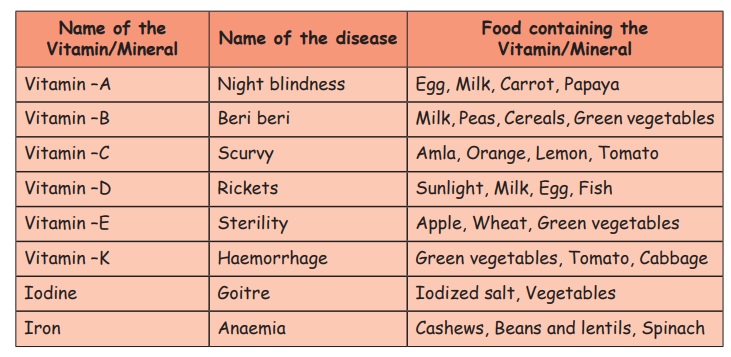
V. Food Pyramid
Food pyramid is designed to make healthy
eating. Depending upon our work, age and sex, the requirement of various
nutrients vary from person to person. For example, growing children need more
proteins in their food. People doing hard physical work (labour) needs more
carbohydrate and fats in their diet. Eating healthy breakfast helps to improve
concentration and it boosts metabolism.
Balanced
diet: The food we
normally eat in a day is our diet. For growth and maintenance of good health,
our diet should have all the nutrients that our body needs, in right
quantities. Such a diet is called balanced diet. Pulses, groundnut, soya beans,
sprouted seeds, fermented foods, banana, jaggery, seasonal vegetables and
fruits provide more nutrients. Therefore, one can have a balanced diet without
much expenditure. Some major food items are given in the table below.
Major
Food Items / Sources
Carbohydrates:
Honey,
Sugarcane, Fruits, Whole grains, Vegetables, Rice
Proteins
: Legumes,
Pulses, Nuts, Soya bean, Green leafy vegetables, Fish, Egg, Milk
Fats:
Egg yolk, Saturated oil, Meat
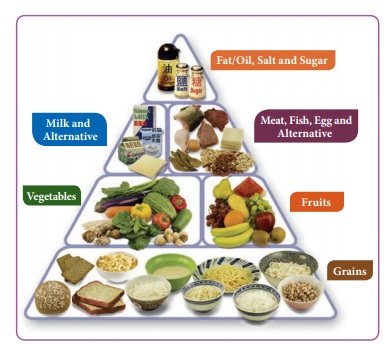
Do you know?
Spinach and Ponnanganni
keerai are some of the low cost, highly nutritive food materials. They contain
more minerals, vitamins, fibrous nutrients available in all seasons.
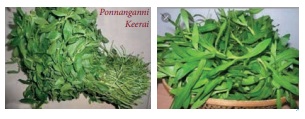
VI. Kitchen Safety
Kitchen is an important place in our
homes. We prepare our food in the kitchen. We use gas cylinders for cooking.
Some of us may use electric stoves. The equipments and the environment in the
kitchen may be little dangerous. So we need to be cautious and careful. What we
should do and shouldn’t do in the kitchen are given below.
* Gas
Gas
catches fire easily. Once gas is leaked there may be dangerous consequences.
So, we need to be careful while handling cylinders. The following table gives
what should we do and what we shouldn’t do while handling gas cylinders.
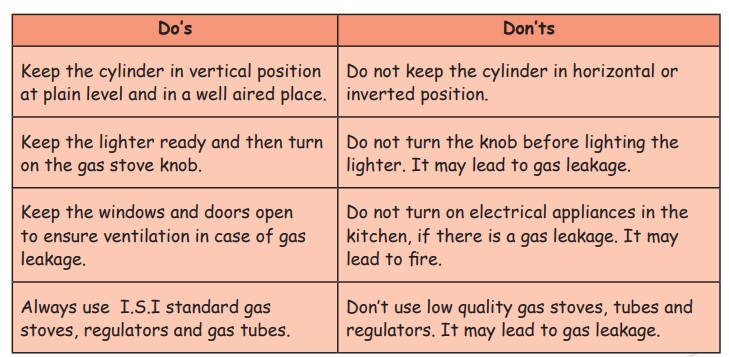
Do’s
Keep the cylinder in vertical position at
plain level and in a well aired place.
Keep the lighter ready and then turn on
the gas stove knob.
Keep the windows and doors open to ensure
ventilation in case of gas leakage.
Always use I.S.I standard gas stoves, regulators
and gas tubes.
Don’ts
Do
not keep the cylinder in horizontal or inverted position.
Do not turn the knob before lighting the
lighter. It may lead to gas leakage.
Do not turn on electrical appliances in
the kitchen, if there is a gas leakage. It may Lead to fire.
Don’t use low quality gas stoves, tubes
and regulators. It may lead to gas leakage.
* Electrical appliances
→ Do
not operate electrical appliances with wet hands, because it leads to electric
shocks.
* Fire
→ Do
not keep the inflammable materials like kerosene etc, near the stoves.
→ In
case of person’s clothes catching fire, cover the person with a thick blanket
or carpet.
→ If
kerosene or oil catches fire, use sand to put out the fire.
→ If
solid materials like wood catch fire, use water to put out the fire.
→ If
an electrical appliance catches fire, unplug the appliances and disconnect the
electricity.
→ Use
proper fire exitinguishers to put out the fire.
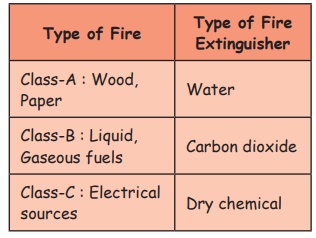
Type
of Fire
Class-A: Wood, Paper
Class-B: Liquid, Gaseous fuels
Class-C: Electrical sources

Do you know?
In order to avoid fire any
one of the following sources is removed.
1. Cut off the fuel
2. Cut off the air supply.
3. Lower the temperature.
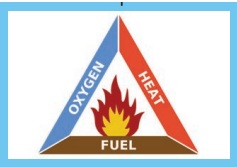
* Burns
→ In case of minor burns, the burnt
area should be held under cool running water for some time and proper medical
treatment should be given.
→ Any blister if formed, should not
be pricked.
